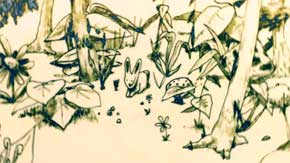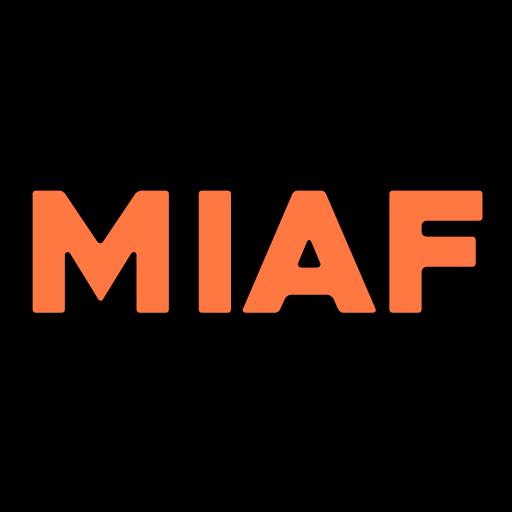Welcome to International Competition Programme 6: Below the Surface – our 6th curation for LIAF 2015 competition programmes, and your 6th opportunity to vote for your favourite animation and tell us why. Please do keep picking up those voting forms and giving us your much-valued feedback. We read every single form, digest each one with our pondering caps firmly in position, and will be bearing your thoughts in mind as we curate for LIAF 2016. Read on for a more in-depth insight into our own thoughts as to why the films that made it into ‘Below the Surface’, made it!
At Barbican book tickets
This programme begins with Ulo Pikkov’s astonishing new work Tik-Tak, yet another of the superb new Estonian films we locked in early for this years’ LIAF. Friendly, quiet, thoughtfully intense, not to mention a very fine past LIAF guest, Pikkov’s career to date is – to say the least – varied. An accomplished puppet animator, he has nonetheless created a body of work that includes scratch/cameraless as well as hand-drawn films. He is a scholarly author, a skilled editor of essays and books and a gifted and generous teacher. In so many ways Tik-Tak is the quintessential Estonian puppet film. It encompasses classic, aged, yet ageless, characters, is as skilfully animated as it is possible to be, depicts a bizarre yet oddly believable transition and is mind-bogglingly complex in its technical prowess. Produced at Nukufilm, a short, lumpy walk from Tallinn’s train station and main market, it is a lavish, creatively saturated example of just what Estonian puppet animation is.

Sand animation, in the right hands, is a wonderful form of animation. At its best it flows with a graceful liquidity that is at odds with the granular nature of the material on hand. Mistakes are nearly impossible to remedy and adding a fuller range of colours to the mix multiplies the complexities many-fold. Cesar Diaz’s Zepo is a stunning example of this form. Making best use of a multi-plane system he is able to bring complexities of design, colour-palette and character/scenery interaction rarely exhibited in sand animation. Many sand animators also struggle to create convincing movement in their human characters but not Diaz who not only has his main character moving freely but also simulates more extreme, even cartoonish, head-long rushes through a crowded forestscape. It is a feast for the eyes even if the final denouement comes as a jolt.
Steven Subotnik has been one of the more consistent contributors to successive LIAF line-ups over the years. He originally trained at Calarts and was mentored by the legendary Jules Engel. Along with partner Amy Kravitz he teaches one of the most highly regarded animation courses in the United States at the Rhode Island School of Design (RISD). Classifying himself as an experimental animator, Subotnik typically begins with a singular visual idea and animates forward from that point. He seldom – if ever – uses storyboards or scripts but instead places his faith is his ability to explore that core idea through the animating process.

Much the same applies to the soundtracks he creates for most of his films. He has a magpie approach to collecting a wide variety of sounds, music and voices and he places great faith in his ability to eventually match fragments of these collected sounds to the images he has created. This more or less organic process often unlocks meanings within the finished works that he never knew existed until this almost accidental pairing of sound and imagery comes together. It is a process that has served him well through a career that has spawned almost twenty films …. and counting.
This year we had several new Subotnik films to choose from. In the end we chose Dandelion for competition. It’s a wonderfully ethereal piece, contains some beautifully detailed hand drawn animation and has something approaching a narrative structure to its all too brief time on screen. Capturing and depicting the ‘weight’ of something like a dandelion in flight is the mark of an animating artisan and Subotnik’s Dandelion does exactly this. Another of Subotnik’s more experimental works – Line – is also screening in this year’s Abstract showcase.

One of Subtonik’s (and RISD’s) most accomplished and prolific graduates would have to be Caleb Wood who graduated in 2011. A brief period interning in New York City taught him that he didn’t really like big cities. In this day and age it is easier to live away from the main metros, find the clear-air to get on with personal films and still be able to work commercially with distant clients as the need and opportunities arise. This combined with a series of residencies (particularly in Japan) more or less sums up Wood’s artistic career to date.
In many ways he is an animator’s animator. He has a natural eye for turning his subjects upside down, inside out and constantly moving them through the viewing axis of the audience.

Subotnik seems to love nothing better than to metaphorically dive into the midst of his subjects or the environments he would have them moving around in. In live action this, of course, is done by simply moving the camera around. In animation, the filmmaker has to move their imagination around and convince the eyes of the audience to go along for the ride. In this Wood is a master of his craft and Goodbye Rabbit, Hop Hop is a textbook example of just how hard he can drive his imagination to create the appearance of a camera tracking through an utterly imaginary world.
Minneapolis does not always ring the loudest of bells when the world’s animation hotspots are being discussed. But it is home to Tom Schroeder who for nearly 20 years has been producing hand drawn animated films that have performed extremely well on the international festival circuit. If any independent animator can claim a ‘break-through’ film, Schroeder’s would have been the white-on-black mini-epic Bike Ride produced back in 2000. Relatively simple in style, utterly personal and (apparently) biographical in nature it introduced a filmmaker who brought a gentle, knowing eye to whatever story he decided to run with. Over the years the techniques became more sophisticated and the stories far more complex but always that sense of a filmmaker with an empathetic eye and a real care for his characters shone through in every film he made.
These days Schroeder juggles his output as an internationally renowned animator with his position as Professor at the Minneapolis College of Art And Design. His latest film, Isola del Giglio, sees him returning to an autobiographic frame of mind, describing it as “an observational sketchbook”. It’s an apt description for a film that purposely has no narrative structure, rather more or less structuring itself as Schroeder sifted through a substantial trove of sketches, live action footage and recorded sounds made on a research trip to the small Italian island that his film is named for. That was back in the early 2000s and his ‘discovery’ of the island resulted from a friendship Schroeder and his Belgian-born wife struck up with a European exchange student whose French family holidayed there. He immediately developed an affinity for one of the small towns on the island, Campese, which he likened to a town featured in a favourite Jacques Tati film and he set about trying to capture a sense of those qualities in his film. If you think the name Isola del Giglio sounds somehow familiar that might have something to with the fact that the island went on to play a starring role in the sinking of the Costa Concordia.
We love a bit of visual cacophony here at LIAF. And we tend to live by the adage that anything that’s worth doing is worth over-doing. Ant’s Song by Russian animator Sasha Svirsky ticked that box well and truly. A riotous spectacle almost from frame one, it attaches a rocket-pack to a tale about a terrible crime witnessed by a colony of ants. This unlikely premise unleashes a sustained torrent of inventive, ever-changing imagery that fires that rocket through a non-stop crazy-ride of a story until it slams in the rock-face at the end of the film otherwise known as the credits. Storyboarding this animated Vesuvius must have been nigh-on impossible and we are fairly certain that just watching it is close to a form of physical exercise.
All good things, the old saying sometimes goes, must come to an end. And sometimes that end ends in the cemetery. Different cultures have different ways of thinking about these collective final resting places, with many choosing to include an element of celebration blended into the emotional mix. Mexican culture has a generous portion of this ingredient stirred carefully into the spectrum of its complex social customs surrounding dealing with death. And why not? If life is for the living, a good life well lived is worth remembering with some joy.

Some of all of this is the creative catalyst for Santolo: Panteon de Dolores by one of Mexico’s more vibrant and successful graphic design and moving media art outfits Llama Rada. They took over one of Mexico’s largest cemeteries and used the cloak of nightfall to transition it’s paths, trees AND gravestones into screens on which to project a myriad of especially animated images ranging in style and complexity. This is no simple, gimmicky outdoor one-off projection fest. Many of the individual components of this ‘multi-screen’ work have been custom-designed for specific monuments within the cemetery. The overall effect is startling, joyous and occasionally respectfully irreverent – something in which the whole is something more than the sum of the parts.
















